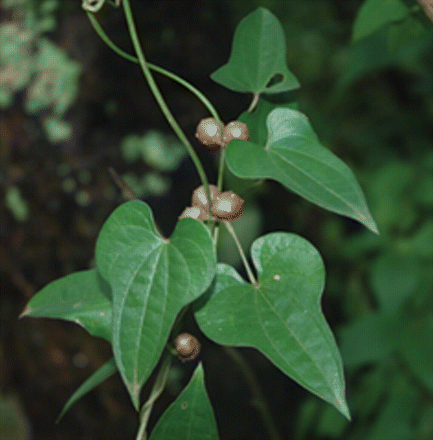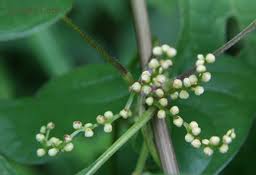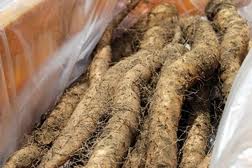Dioscorea Polystachya: Yam C
Just like Rambo movies, there is Yam A, Yam B and, yes, a Yam C, the Chinese Wild Yam or the Cinnamon Vine yam, either way we get Yam C, botanical name, Dioscorea polystachya aka D. oppositifolia (Dye-os-KOH-ree-uh or in Greek thee-oh-skor-REE-uh) [op-os-i-ti-FOH- lee-uh]. Dioscorea oppositifolia only grows in India, where I presume it is eaten. D. polystachya is the one growing in North America. D. oppositifolia is called by some websites D. batata. Regardless, the accepted name for now for the Chinese Yam is Dioscorea polystachya
In some ways Yam C (Dioscorea polystachya) resembles both Yam A and Yam B (Dioscorea alata, D. bulbifera.) It would almost seem to be a composite. And, yes it has a very edible root and air potatoes. It’s fairly easy to identify, if you know how your three yams differ. A review:
Yam A, Dioscorea alata, (uh-LAY-tuh) the winged yam, has a very square stem, stem edges can be tinged in purple, it twists lower left to upper right (Z-twist) its leaves are in pairs and more arrow shape than heart-shaped. Its in-the-air bulbils are cylindrical or misshapen lumps, dark brown. The vine can grow to 50 or 60 feet. Its underground root should be cooked once. Its in-the-air bulbils are considered edible but not too palatable. Yam A is, officially, in three southern states and Puerto Rico.
Yam B, Dioscorea bulbifera, (bul-BIFF-er-ah) the “air potato vine” has a thick round stem, green. It twists lower right to upper left (S-twist) its leaves are round-shaped heart and singular, alternating. The vine can grow to 80 feet. In-the-air bulbils are round, either tan and smooth, or dark brown with tan pimples. Its underground root needs to be cooked twice, or more and then try carefully. If still bitter discard. Its bulbils are generally not considered edible. Read more about that in the specific article on Yam B. D. bulbifera is in five southern states, officially, and Puerto Rico.
Yam C, Chinese Wild Yam, or Cinnamon Vine, the Dioscorea polystachya. Its deeply lobbed leaves can be round-heart- to sword-handle shaped to arrow-heart shaped, but to me they resemble a cartoon outline of a rat’s head, with a long nose, large ears. Better still, they resemble the leaves of the Smilax bona nox. Its leaves
can be opposite on the lower stem, alternating farther up, or arranged in a whorl of three. The vine is round like the D. bulbifera but wiry, it twists lower left to upper right, Z-twist, like the D. alata, to 15 feet. If it blooms its flowers smell of cinnamon. Its leaf margins, petioles, and stems can be tinged reddish purple. The root should be cooked. Some authors say it can be eaten raw but with so many varieties possible that would not be advised. Its in-the-air bulbils, often pea size sometimes to golf ball size, are edible and can be cooked up like little potatoes. Each vine produces about 20 bulbils a year. Rats like them, and other small animals. New leaves have a bronze tint which keeps it from being confused with the similar looking Morning Glory. In northern climates D. polystachya is the only local yam.
Yam C, came to the United States as a food and an ornamental crop in the 1800s. In a 1970 survey it was not reported escaped from cultivation but by 1986 was reported root loose and fancy free. Unlike Yam A and Yam B, Yam C, the D. polystachya, apparently gets around. By 2002 it was reported in 24 states from Vermont south to Florida, west to Illinois and Texas. It’s also been reported in two more since, Wisconsin and Arizona, putting it in 26 states as well as Washington DC, but not Puerto Rico. In Texas it has become a naturalized “noxious weed.” That title might change if food prices keep rising. In Tennessee it is a Rank-1 Severe Threat Species. It is becoming an increasing problem in southern Ohio where it is controlled by intense mowing. It is also a favorite ornamental, so your first sighting of Yam C might be inside in the middle of winter in a container.
One-year-old roots weigh about 3 ounces, two-year-old roots, a pound. The root, in good soil, can grow up to three feet long and weight up to five pounds. Its flavor is between a sweet potato and a regular potato. It is 20% starch, 75% water, 0.1% B1, and has 10 to 15 mgs vitamin C. The most common use is cooked like a potato. The Japanese prefer it raw. However, varieties can differer and I do not recommend you eat it raw. Cook it, or experiment with it raw very carefully.
Yam C, Dioscoria polystachya, is also called the aformentioined D. oppositifolia but I am not convinced they are exactly the same plants which is why I do not recommend the D. polystachya be eaten raw. Dioscorea honors Pedianos Dioscorides, a Greek physician of the first century AD whose book on medicinal herbs Materia Medica was the standard for nearly 2000 years. Polystachya means many flower spikes. Batata is a Caribbean native word for “potato” and oppositifolia means opposite, as in the leaves. Remember, D. polystachya in North America, D. oppositifolia in India.
Green Deane’s “Itemized” Plant Profile
IDENTIFICATIOIN: Dioscorea polystachya: ”Chinese Yam, Cinnamon Yam Vine.’ Large lance-shaped leaves, opposite on lower or young stems, alternating higher up, can have whorls of three, climbs from lower left to upper right. In-the-air bulbils pea to golf ball size, usually smaller than larger. Long, skinny underground root to five pounds.
TIME OF YEAR: Fall. In Florida vine dies December through February making locating difficult unless you mark it.
ENVIRONMENT: Yams do well in sun or partial shade and prosper with ample rainfall. They require good drainage, and therefore, are often planted on mounds or ridges. This one likes to be watered.
METHOD OF PREPARATION: Underground roots, cooked peel, then sliced or mash, bake or chill it and use in a “potato” salad. Some reportedly use it raw. Proceed with caution. Try a very little first and wait a day. In-the-air bulbils cooked, usually boiled like potatoes.
HERB BLURB
Externally the raw root has been used to speed up healing because it contains allantoin, a cell proliferant. Leaf juice can be used to treat snake bites and scorpion stings.
28 Feb. 2006: Abstract: ”A water extract as a viscous solution was obtained from the yam Dioscorea opposita tuber mucilage tororo, and its functional properties were demonstrated. The protein content was about 280 g/mL extract, and the main protein bands with an MW of 33 kDa without 2-mercaptoethanol (2-ME) and 31 kDa with 2-ME were detected by SDS-PAGE. The water extract possessed high antioxidative activity and scavenging activities against superoxide anion and hydroxyl radicals. However, it showed no inhibitory activity against angiotensin I-converting enzyme. The yam tuber contains relatively high contents of vitamins, different micro- and macroelements, enzymes, and dietary fibers. The yam D. opposita tuber will be increasingly regarded as a health-promoting food.”





Variety. Different tastes. Diffrent textures. Affected by different bugs and weather thus increasing the chances that some food will grow despite pests and weather.
Thanks for this, Green Deane! Great site and I’m adding it to my list. We are on a new farm in the north Georgia mountains, and just learning a few of the promising plants around here that were unfamiliar before. D. polystachya was one of them, and now I know! Can’t wait to dig for roots in the next month or two! Good thing I have a trenching spade.
Not to be mean, but do you wish you hadn’t planted that now? I am saying this as it is almost a decade later and the Chinese Yam and Air Potato have become such a severe threats. This vine has taken over a friend’s property in East Tennessee. Rank 1 Severe Threat species. Please do NOT plant this extremely invasive vine unprotected in the ground. What you see above the earth is just a tiny fraction of what is below the earth. The vine can grow from just a centimeter of tuber and can also grow after being “reawakened” from being dried, dead, and gone for a whole season and just laying on some soil in the summer! Dispose of all components of this vine properly, and do not use as compost or mulch. Not a plant that will die without poison. Kill by finding the place where the vines intersect with the ground, cutting them in half there and creating other cuts about a 1.5′ away from the original cuts to keep the vine from growing back together, and applying full strength concentrated stump killer to the ends that are still in the ground. Give 4-6 weeks for full results. Depending on which state you live in Air Potato Beetles may be available by mail.
Hello, Just found this site in my search to understand what is growing in a corner of my garden. It was called a “Cinnimon Vine” when I purchased it and planted it two years ago. Last winter it died back to the ground; so I thought I might have lost it. However this year it sprang up, created about 100 vines, each running 10-30 ft and creating their own vines. I literally had to find a way to stake it, then the stake fell over onto the wire I had encircled it with (to keep the rabbits off it).
Now I am finding literally hundreds upon hundreds of bulbils ranging from tiny to large pea in size. I called the place where I had purchased it and they told me those bulbils were ok to eat; so I brought them in and roasted them with a little olive oil and sea salt. They made a delicious cruncy snack. (I noticed the following day after eating those the evening before that my feet/toes were not hurting and my ankles were not stiff. I had been concerned about gout as my toes/ankles had been hurting for several months prior to this.) That evening I ate a few more of the roasted bulbils and today my feet are still not hurting. I have no idea what the connection is, but I do believe there is one. If you have any clues as to how these bulbils are connected to gout, I would certainly appreciate knowing.
I have not dug up the root as my reason for planting this vine was to have something in the ground for when it just might be needed one day for food.
I took at least 100 of the bulbils and scattered them along one of my fence lines, hoping they will root there. Not sure they will because of the much grass in that area but will see.
Love your site!
I have to say these are under rated at a snack. I guess I am referring to what you call Yam C. In any case I know them as “toaster taters” and with good reason. Slice into thin strips, baste with olive oil and season to taste (I use Greek seasoning and Spiceberry) seal tightly in a tinfoil envelope and pop in toaster on high twice (at least on my toaster but you can tell when they are done) and enjoy!
I have Yam C in my back yard. The roots don’t seem too big, but I can easily harvest a meal’s worth of tubercles in about 5 minutes. My question is this: do I need to peel the little tubercles as I would the larger tuber before cooking? It would be so convenient to just throw them in a frying pan with butter without peeling.
Thanks
No, they do not have to be peeled with Yam C.
I put the small tubers in my rice cooker and cook them with the rice. In Japan they also eat the Yam C sprouts in the spring. I would like to try that but would like to know if the plant will come back if the first sprouts are harvested.
Question # 2, I understand that the little air tuber you plant does not become the large yam that is later harvested from the earth. In other words, a subsidiary yam forms off of the little air tuber. Does anyone understand the growth process? Thanks for any help. j.
Hi Dean,
Thank you for this write up. I’m growing cinnamon vine in my garden in Maine and love the little air potatoes it produces, but I’d love to get my hands on varieties with larger air potatoes. If you can get your hands on larger varieties I’d love to buy a few off you. Golf ball sized sounds amazing!
Cheers,
Greg
I found a male vine of these (the plant is dioecious) with many little bulbils in Camden, NJ. I took some home about 15 years ago… now I have thousands of them! I let them go all around my garden and harvest a few now and then. In the sandier portions of the garden, just topped with a few inches of richer soil, the roots can become enormous. The largest I ever dug up was nearly 3 feet long, 4 inches in diameter at the thickest and weighed about 7 pounds.
I usually shred them and mix in Italian seasoning, then flatten the mash into patties and fry in olive oil.
The Cinnamon Vine or Yam “C” grows as an escaped garden ornamental in my area of North Arkansas. I have planted the bulbils in a large pot (to keep them from spreading) with a large tomato cage as a trellis and have harvested some smaller roots after two or three years that had curled around the inside of the pot. An Asian market in my area has them for sale also. These are very long and large. I have also seen references and bulbil sources for a variety from Japan called the Mountain Yam or Dioscoria japonica that sounds very similar to the Chinese or Cinnamon Vine. Do you know if these are different names for the same plant or if they might be different? Also, several scarce sources have mentioned that the leaves of Cinnamon Vine are edible as well. Do you have any knowledge of this? I love your site and your videos on YouTube as well. Keep up the good work. Is there any chance of a book in the future? Thank you.
Even botanists can’t sort out all the names given to the various yams.
Any word on if the leaves might be edible as well? Thank you.
As far as I know no leaves of the genus are edible.
Mountain yam is Dioscorea hamiltonii
Deane,
With regard to plant identification in general, are you familiar with the works of Stephen Harold Buhner? And if you are, have you ever tried it?
D. opposita is an outdated name for both D. polystachya (Chinese yam, aka D. batata) and D. oppositifolia (Indian). Since “opposita” sounds a lot like “oppositfolia,” people who used the D. opposita name for D. polystachya think that D. oppositfolia is the same as D. polystachya. Including, unfortunately, a lot of government agencies and universities which should know better.
I am interested to plant a Chinese Yam farm, but I need Yam seeds for plant. Can you sale some yam seeds to me? I don’t know how many seeds can be used for planting 1000 square metres? Please let me know if you can do it. Thanks
Rebecca’s comment is right on the money. D. polystachya and D. bulbifera are both extremely invasive in the Eastern US. There is a huge biocontrol effort going on in Florida using the air potato beetle to fight D. bulbifera infestations. Here in Ohio, D. polystachya is becoming a big problem in natural areas. Think twice about growing these plants!
Chinese yam vines are taking over areas of county park woodlands in Montgomery Co. Maryland. The little sprouts come up everywhere, plus established large vines are climbing up and covering native spicebush and small trees, inhibiting their growth. There is not the park staff nor volunteer resources to combat non-native invasive species growing unchecked in natural areas.
They are destroying native habitat!
If you insist on growing such plants, insure they can’t spread, and responsibly remove them when you move away or can no longer manage them.
Eat the Weeds.